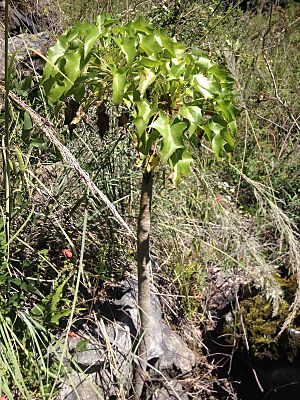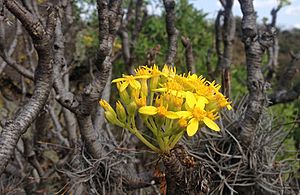Pittocaulon praecox facts for kids
Quick facts for kids Pittocaulon praecox |
|
|---|---|
 |
|
| Conservation status | |
| Scientific classification | |
| Genus: |
Pittocaulon
|
| Species: |
praecox
|
| Synonyms | |
|
Cineraria praecox Cav. |
|
The Pittocaulon praecox is a special plant that helps define its entire group, called a genus, named Pittocaulon. It's like being the main example for a whole family of plants, the Asteraceae family, which includes sunflowers and daisies. This plant also grows in more places than any other plant in its genus.
Contents
Meet the Palo Loco Plant
The Palo Loco plant is a deciduous shrub or a small tree. This means it loses its leaves every year, just like some trees in autumn. It can grow up to 4 meters (about 13 feet) tall. Its stems are thick and juicy, like a succulent plant, and they stand straight up. They are light gray and branch out in a way that looks like a candelabrum, which is a fancy candle holder with many arms.
The leaves of the Palo Loco plant are smooth and shiny. They are shaped like a heart at the bottom and grow in bunches at the top of the branches. Each leaf has a long stem, called a petiole, which can be up to 17.5 cm (about 7 inches) long. The edges of the leaves are smooth, but they have 5 to 8 pointy parts, called lobes.
The flowers of the Palo Loco plant grow in groups called inflorescences. These groups have five or six parts that look like yellow petals. The fruit of the plant is small, less than 1 cm (about 0.4 inches) long. It's a dry, cylinder-shaped fruit called an achene, and it has a fluffy top made of white bristles, like a tiny dandelion seed.
Where Palo Loco Grows
This plant naturally grows in the central and southern parts of Mexico. It likes places that are semi-arid (meaning they don't get much rain) and temperate (meaning they have mild temperatures). The Palo Loco plant has short roots, which helps it grow on thin or bumpy soil.
It especially loves to grow on rocky ground made from old igneous rock, which is rock formed from cooled lava. You can find it thriving in places like the Nealtican malpaís and the Pedregal de San Ángel in Mexico City. The Palo Loco plant is so common in the Pedregal de San Ángel that the area's dry, desert-like plant community is often called "matorral de palo loco," which means "Palo Loco scrubland."
Traditional Uses of Palo Loco
People have used the Palo Loco plant for a long time in traditional medicine. They make a special tea, called an infusion, from its leaves. This tea is used as a natural remedy to help with problems like rheumatism (sore joints), wounds, and skin rashes, also known as dermatitis.
Images for kids
See also
 In Spanish: Pittocaulon praecox para niños
In Spanish: Pittocaulon praecox para niños




